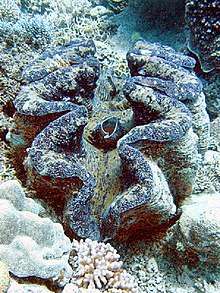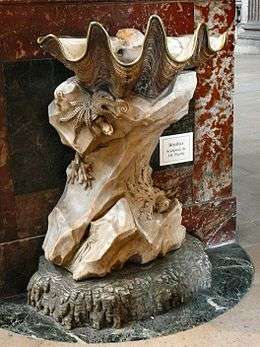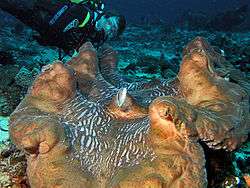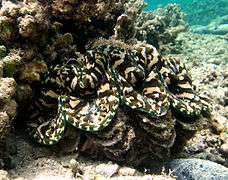Tridacna
Tridacna is a genus of large saltwater clams, marine bivalve molluscs in the subfamily Tridacninae, the giant clams. They have heavy shells, fluted with 4 to 6 folds. The mantle is brightly coloured. They inhabit shallow waters of coral reefs in warm seas of the Indo-Pacific region.[2] These clams are popular in marine aquaria, and in some areas, such as the Philippines, members of the genus are farmed for the marine aquarium trade. They live in symbiosis with photosynthetic algae (zooxanthellae). Some species are eaten by humans.
| Tridacna | |
|---|---|
 | |
| Giant clam (T. gigas) | |
| Scientific classification | |
| Kingdom: | Animalia |
| Phylum: | Mollusca |
| Class: | Bivalvia |
| Subclass: | Heterodonta |
| Order: | Cardiida |
| Family: | Cardiidae |
| Subfamily: | Tridacninae |
| Genus: | Tridacna Bruguière, 1797 |
| Species | |
|
See text | |
All species in genus Tridacna are protected under CITES Appendix II.[3]
Systematics and phylogeny
The genus contains two subgenera and the following species:[4][5]
- Tridacna lorenzi Monsecour, 2016 -- Mascarene region
- Tridacna noae (Röding, 1798) -- China sea
Subgenus Tridacna (Tridacna)
- Tridacna derasa (Röding, 1798) -- Western Pacific
- Tridacna gigas (Linnaeus, 1758) -- Tropical Indo-Pacific
- Tridacna mbalavuana Ladd, 1934 (= Tridacna tevoroa Lucas, Ledua & Braley, 1990) -- Fidji, Tonga
Subgenus Tridacna (Chametrachea)
- Tridacna squamosina Sturany, 1899 (= Tridacna costata Roa-Quiaoit, Kochzius, Jantzen, Al-Zibdah & Richter 2008) -- Red Sea
- Tridacna crocea Lamarck, 1819 -- Western Pacific
- Tridacna maxima Röding, 1798 ( =Tridacna elongata) -- Tropical Indo-Pacific
- Tridacna rosewateri Sirenho & Scarlato, 1991 -- Mascarene region
- Tridacna squamosa Lamarck, 1819 -- Tropical Indo-Pacific
| Wikimedia Commons has media related to Tridacna. |
An alternative older classification recognises a third subgenus Persikima containing T. derasa and T. mbalavuana.[6] Recent biochemical studies have suggested that there may exist morphologically indistinct cryptic species.[2][7]
Anatomy
Compared to other clams, the soft mantle that secretes the shell is greatly expanded. The clams even have small lens-like structures called ocelli through which light penetrates.[8]
Ecology and behaviour

Tridacna clams are common inhabitants of Indo-Pacific coral reef benthic communities in shallower waters.[9] They live in symbiosis with photosynthetic dinoflagellate algae (Symbiodinium) that grow in the mantle tissues.[10] Light penetrates the mantle through small lens-like structures called ocelli.[8] They are sessile in adulthood. By day, the clams spread out their mantle so that the algae receive the sunlight they need to photosynthesize, whereas the colour pigments protect the clam against excessive light and UV radiation. Adult clams get most (70-100%) of their nutrients from the algae and the rest from filter feeding.[11] When disturbed, the clam closes its shell. The popular opinion that they pose danger to divers who get trapped or injured between the closing sharp-edged shell is not very real, as the closing reaction is quite slow. Their large size and easy accessibility has caused overfishing and collapse of the natural stocks in many places and extirpation in some of the species.[12] They are being sustainably farmed in some areas,[13] both for the seafood market in some Asian countries and for the aquarium trade.[14]
Tridacna clams can produce large white pearls with an undulating, porcelain-like surface,[15] which may be described as "non-nacreous pearls". The "Pearl of Lao Tzu", also known as the "Pearl of Allah", is the world's largest pearl weighing 6.4 kilogrammes; it was said to have been found inside a Tridacna gigas by a Filipino diver in 1934.[16][17]
Artistic use
Over a hundred examples of carved Tridacna shells have been found in archaeological expeditions from Italy to the Near East. Similar in artistic style, they were probably produced in the mid-seventh century, made or distributed from the southern coast of Phoenicia. The backs and interior perimeters of the shells show animal, human, and floral motifs, while the interiors typically show recumbent sphinxes. The umbo of the shell is in the shape of a human female or bird's head. They were probably used to store eye cosmetics.[18]
Images

 Tridacna gigas
Tridacna gigas- Tridacna maxima

 Tridacna squamosina
Tridacna squamosina
Notes
- "The Paleobiology Database". Paleodb.org. Retrieved 2012-05-20.
- Huelsken, T., Keyse, J., Liggins, L., Penny, S., Treml, E.A., Riginos, C. (2013) A Novel Widespread Cryptic Species and Phylogeographic Patterns within Several Giant Clam Species (Cardiidae: Tridacna) from the Indo-Pacific Ocean. PLoS ONE, DOI: 10.1371/journal.pone.0080858.
- "Checklist of CITES species".
- WoRMS. (2009). Tridacna. Accessed through the World Register of Marine Species at http://www.marinespecies.org/aphia.php?p=taxdetails&id=205753 on 2009-01-08.
- Schneider, J.A.,and O´Foighil, D. Phylogeny of Giant Clams (Cardiidae: Tridacninae) Based on Partial Mitochondrial 16S rDNA Gene Sequences. Molecular Phylogenetics and Evolution Vol. 13, No. 1, October, pp. 59–66, 1999
- Benzie,J.A.H. and Williams,S.T. Phylogenetic relationships among giant clam species (Mollusca: Tridacnidae) determined by protein electrophoresis. Marine Biology (1998) 132: 123±133
- Mohamed, N.M. et al., Molecular Genetic Analyses of Giant Clam (Tridacna sp.) Populations in the Northern Red Sea. Asian Journal of Biochemistry, 1 (4): 338-342 (2006)
- Murphy 2002, p. 25
- Rosewater, J., The Family Tridacnidae in the Indo-Pacific. Indo-Pacific Mollusca, 1:347-408. 1965
- Jantzen, C., et al. Photosynthetic performance of giant clams, Tridacna maxima and T. squamosa, Red Sea. Marine Biology (2008) 155:211–221
- Klumpp,D.W., Lucas,J.S., Nutritional ecology of the giant clams Tridacna tevoroa and T. derasa from Tonga: influence of light on filter-feeding and photosynthesis. Mar. Ecol. Prog. Ser. Vol 107, 1994
- J.W. Copland and J.S. Lucas, (Eds.), Giant Clams in Asia and the Pacific Vol. 9, Australian Center for International Agricultural Research, Canberra(1988).
- Murphy 2002, p. 28
- "Aquarium Invertebrates: A Trip to an Indonesian Coral and Clam Farm". advancedaquarist.com.
- CIBJO (2007) THE PEARL BOOK:: Natural, Cultured & Imitation Pearls: Terminology & Classification – 5.216. Tridacna gigas (p. 28)
- Natural History – PICKS FROM THE PAST: NOVEMBER 1939 – The Pearl of Allah
- Prager, Ellen (2011), Sex, Drugs, and Sea Slime: The Oceans' Oddest Creatures and Why They Matter, The University of Chicago Press, ISBN 978-0-226-67872-6 (pp. 64-64)
- Markoe, Glenn. Phoenicians. British Museum Press (2000).
References
- Murphy, Richard C. (2002). Coral Reefs: Cities Under The Sea. Princeton, New Jersey: The Darwin Press. ISBN 978-0-87850-138-0.CS1 maint: ref=harv (link)
- How to Care for Tridacnid Clams FishChannel.com